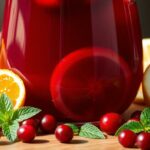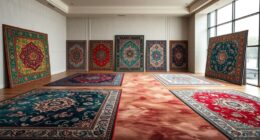If you've added too much lemon juice to your salad dressing, don't worry! You can balance the acidity by drizzling in more olive oil, incorporating honey or maple syrup, or adding creamy ingredients like yogurt or mashed avocado. Fresh herbs and spices also help distract from the tartness, while diluting with water or broth can tone it down. Each method offers a way to enhance flavor, so you'll discover which works best for you!
Key Takeaways
- Gradually whisk in additional olive oil to mellow the sharpness of the lemon juice and enhance overall flavor.
- Stir in a small amount of honey or maple syrup to neutralize tartness and create a more balanced taste.
- Add creamy ingredients like yogurt or mashed avocado to soften the acidity and provide a richer texture.
- Incorporate fresh or dried herbs and spices to distract from the overpowering lemon flavor and enhance complexity.
- Dilute the dressing with water or vegetable broth, and consider adding extra chopped vegetables for improved flavor and texture.

When you accidentally add too much lemon juice to your salad dressing, don't worry—there are several easy ways to fix it. First off, you can balance that zesty acidity by adding more olive oil. Since olive oil is a fat, it helps mellow out the sharpness of the lemon juice. Simply drizzle in a bit more olive oil, whisk it in, and taste as you go until you've hit that perfect balance. This not only reduces the tartness but also enhances the overall flavor of your dressing.
If you're still feeling the punch of the lemon, consider incorporating a sweetener. Honey or maple syrup can work wonders in neutralizing the tartness brought on by the excess lemon juice. Just a tiny drizzle can make a significant difference. Start with a small amount, and stir it into your dressing. Taste again, and you'll likely notice the flavor becomes more rounded and pleasant.
Creamy ingredients can also save the day. Think about adding yogurt, sour cream, or even some mashed avocado. These ingredients help soften the acidity while providing a rich texture to your salad dressing. If you opt for yogurt or sour cream, you'll not only balance the lemon but also add a delightful creaminess that elevates your dressing. If you're using avocado, mash it well before mixing it in, ensuring it blends smoothly with the olive oil and lemon juice.
Another effective method is to introduce additional herbs or spices. Fresh or dried herbs like basil, oregano, or dill can add complexity and depth to your dressing. This distracts from the overpowering lemon flavor and creates a more balanced taste. Spices like garlic powder or onion powder can also enhance the flavor profile, making the lemon juice feel less dominant. Don't hesitate to experiment with what you have on hand, as spices can bring your dressing to life.
Finally, if you find the dressing is still too tangy, consider diluting it by adding additional ingredients. Water or vegetable broth can help tone down the acidity without compromising the flavor. If you have extra chopped vegetables, toss those in too. These additions not only balance the dressing but also contribute to the overall texture and flavor of your salad. Just remember to keep an eye on the seasoning; you might need to adjust the salt and pepper to maintain that savory kick.
With these simple tricks, you can rescue your salad dressing from the clutches of too much lemon juice. Whether it's through olive oil, a touch of sweetness, creamy components, herbs, or dilution, you'll have your dressing back on track in no time. Enjoy your salad with the perfect balance of flavors!
Frequently Asked Questions
How Do You Counteract Too Much Lemon Juice?
To counteract too much lemon juice, you can add more fat, like olive oil or avocado, to balance the acidity. Additionally, incorporating a pinch of sugar or honey can help mellow out the tanginess without overpowering the dish. When fixing overly sour soup recipes, consider stirring in some creamy components, such as yogurt or coconut milk, to enhance the flavor and create a more harmonious balance. These adjustments can transform your dish into a more enjoyable culinary experience.
A touch of sweetness, such as honey or maple syrup, helps mellow the tartness.
If you want a creamy texture, consider incorporating yogurt or sour cream.
Diluting with water or broth can also tone down the lemon flavor.
Finally, gradually mix in more herbs or spices to enhance the overall taste.
How to Fix a Salad Dressing That Is Too Acidic?
Did you know that nearly 60% of people find salad dressings too acidic?
To fix a salad dressing that's too acidic, try adding more olive oil to create a smoother balance. You can also stir in a bit of honey or maple syrup to counteract the tartness.
Additionally, creamy elements like yogurt or avocado can help neutralize the acidity. Always taste as you go, adjusting gradually until you achieve the flavor you love.
What Cuts the Bitterness of Lemon?
To cut the bitterness of lemon, try adding a sweetener like honey or sugar; it'll balance the tartness nicely.
Incorporate fats, such as olive oil, to create a smoother texture and richer flavor.
Fresh herbs or spices can also distract from the bitterness while enhancing the dish.
Don't forget a pinch of salt to elevate sweetness or a splash of sweeter vinegar for added depth.
These simple adjustments can transform your dish!
What Can Neutralise Lemon Juice?
To neutralize lemon juice, you can add sweeteners like honey or sugar to balance the acidity.
Incorporating fats, such as olive oil or avocado, softens the sharpness while creating a richer flavor.
Creamy elements, like yogurt, can also help mellow the tartness.
You might dilute the lemon juice with water or vegetable broth to lessen its intensity.
Finally, fresh herbs or spices can introduce complexity, distracting from the lemon's overwhelming acidity.
Conclusion
So, the next time you accidentally go overboard with lemon juice in your salad dressing, don't fret. Just add a splash of olive oil and a teaspoon of honey, and watch how the flavors meld together like old friends at a reunion. They balance each other perfectly, turning your tangy mishap into a delightful creation. It's funny how a little adjustment can transform a salad from sour to sensational, just like life's little surprises. Enjoy your delicious fix!
Cindy thoroughly researches juicing trends, techniques, and recipes to provide readers with practical advice and inspiration. Her writing style is accessible, engaging, and designed to make complex concepts easy to understand. Cindy’s dedication to promoting the advantages of juicing shines through her work, empowering readers to make positive changes in their lives through the simple act of juicing.
















